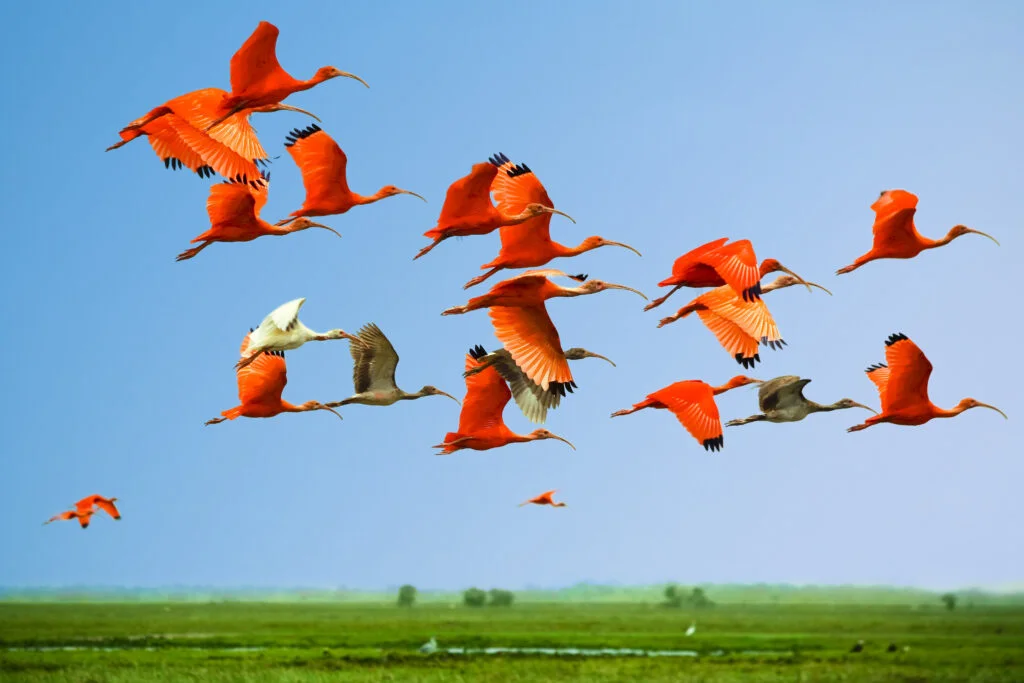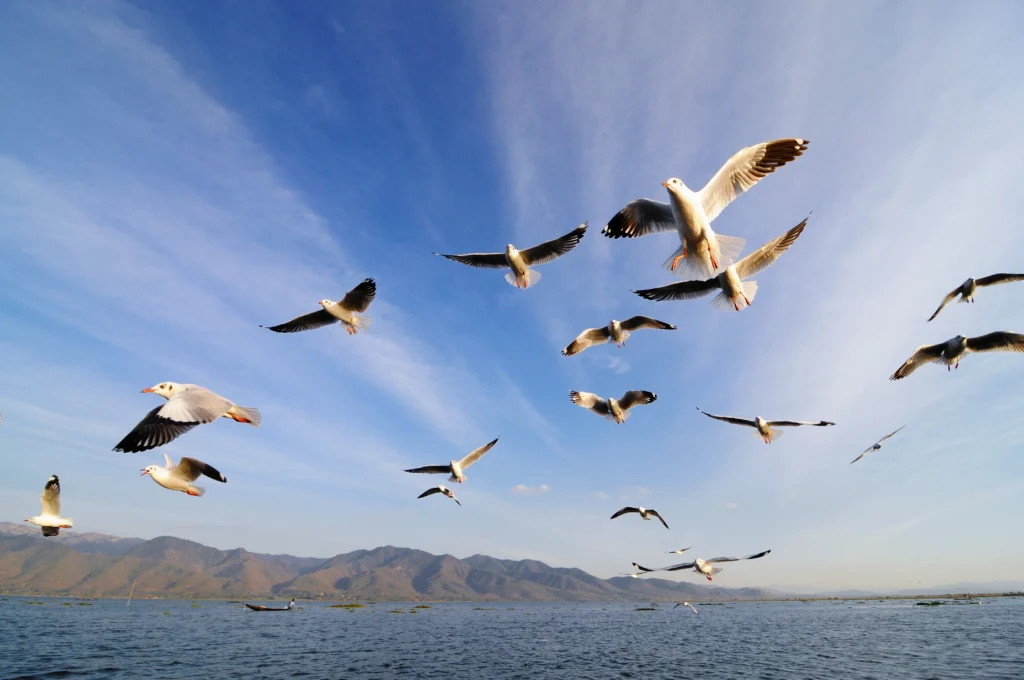Omens In The Sky

Ever wondered why some birds fly in a V-shaped group? Is it an omen or a kind of warning or is it just a characteristic of migrant birds?
The distinctive V-shaped formation of migrating birds has intrigued philosophers and mystics since ancient times. It is strongly believed that such aggregations are cradles of omens. However, scientists claim it is a method used by migrating birds to conserve energy! “The reason why birds can fly and we can’t is simply because they have perfect faith, for to have faith is to have wings.” (J.M. Barrie, The Little White Bird.)
Auspices and Omens
The Etruscans, who lived in central Italy between 1400 and 300 BC, believed that human destiny is written in the sky. The practice of augury, the reading of the flight of birds to foretell the future, indicates their Middle Eastern origin. To the Etruscans, every natural phenomenon was the expression of human fate and God’s will.
So the prediction of future events was organised and rigidly structured. The art of augury was somehow similar to modern fortune-telling, but linked to religion as it was considered to be the interpretation of God’s will.
Premonitory Flocks
Special priests named augurs formulated provisions for individuals, companies, and even governments, based on the height, direction and size of the bird or flock examined.
Before ‘taking the auspices,’ i.e. predicting the favourable or unfavourable outcomes of an endeavour, augurs also considered whether the bird was flying in a group or alone, what call it made and what species it was.
Then the augur would trace a square on the ground and from there he would observe at length the phenomenon before releasing the prevision.
Perilous Prophecy
‘Taking the auspices’ derives from the Latin auspex, a word that is a sum of two words, avis (bird) and spex (observer,) literally ‘one who looks at birds.’ Augury, the practice of prophecy based on the flight of birds, was held in high respect by the Etruscans and became popular in ancient Rome, spreading rapidly throughout the Empire.
War, commerce, love and health-related queries were submitted for the approval or rejection of gods through Augury. Roman historian Livy famously said: “Who does not know that this city was founded only after taking the auspices? That everything in war and peace, at home and abroad, was done only after taking the auspices?”
Spooky Past
Omen deciphering through observation of bird flights was practised long before by the Assyrian-Babylonians, between 1900 and 1600 BC. In the 14th century BC, the art of augury was developed in the court of the king of Alasya (Enkomi, Cyprus) who sent an ‘Eagle Diviner’ to Egypt.
Later, the practice spread to ancient Greece. Calchas, the renowned bird-watcher of Agamemnon, excelled in the art of augury and led the Greek army to Troy predicting that Troy would be taken in the 9th year of war.
Roman Presage
Legend says that the twins, Remus and Romulus, quarrelled about the location of Rome. Romulus wanted the city on the Palatine, while Remus proclaimed that the Aventine Hill was more strategic. At last, they agreed to test their augury competence by counting the birds they would see in a given timeframe. According to Plutarch, Remus saw six vultures whereas Romulus saw twelve. Rome was thus built on the Palatine.

Reading bird flight became an essential part of Roman culture. They maintained that if there are gods, they should care for men and therefore they must send signals of their will, obviously from the sky. In ancient Rome, any important decisions were settled only after a positive auspicium was obtained from flying omens. Birds were Jupiter’s messengers.
There were five classes of auspices and the oldest were related to birds, such as ex avibus (observation of birds) and ex tripudiis (observation of the feeding behaviour of sacred chickens.) Less important were three other classes, including ex quadrupedibus (observation of dog, horse, wolf and fox behaviour,) ex diris (apocalyptic events) and ex caelo (thunder, lightning.)
Avian Supremacy
Only some species, named aves augurales, could validate the will of gods, including ravens, vultures, woodpeckers, owls and eagles.
Signs were divided into alites, derived from the observation of bird flight, and oscines, from deciphering their voices. The alites included region of the sky, height and type of flight, behaviour and place where the bird would rest. Eagle and vulture were important species of the alites, but other birds were also included, even though a sign from an eagle would prevail over that from a woodpecker or vulture. The oscines involved the study of the pitch and direction of the singing of a few species, including crows, ravens, owls and hens. Each observation could yield a favourable or unfavourable omen depending on where the vocalisation originated.
Earth Jubilation
The ex tripudiis (sacred dance) auspice interpreted the feeding patterns of sacred chickens. This was of particular importance for the army and military operations. The pullarius (keeper of the divine chickens) was charged to release the animals and feed them on special occasions.
If the chickens refused to come out of the cage or to eat, or if they vocalised fearfully, the omen was inauspicious. Conversely, if the chickens feasted calmly and a morsel fell on the ground, this was considered a benign favourable sign, named in Latin tripudium solistimum (earth jubilation.)
Legend acknowledges that during the naval battle of Drepanum against the Carthaginians in 249 BC, the consul Claudius Pulcher pushed the sacred chickens overboard because they refused to eat their bread. The subsequent catastrophic defeat was attributed to the unheeded bad omen!
Aloof Drifting
Ancient Romans and Etruscans are not alone in their obsession with bird flight. The distinctive V formations of geese, herons and other species travelling in highly organised groups have intrigued scientists, too.
Military pilots during World War II were instructed to fly in a tight V shape. Unfortunately, they spent more time watching the position of the plane in front than checking out for enemy aeroplanes, but they observed a diminution in fuel consumption. The same benefits have been noted in civil aviation. If one wing tip is kept constantly in the wake of a preceding plane, a jet can reduce its fuel consumption by up to 18%.
Similarly, the peloton (French term for platoon, bunch, group) in a cycle race makes cycling easier, with up to 40% reduction in air resistance, for the riders who save energy by cycling close, and particularly behind (drafting or slim-streaming) the front group of colleagues.
The Perfect Vortex
For an aeroplane pilot is tricky to keep the tip of the wing exactly within the region of a lifting vortex, but for a bird there is the additional problem of air disturbance caused by the flapping wings of the neighbours. Some birds take a while to get into formation because they need a lot of coordination and spatial synchronisation.
Birds are required not only to adjust their relative position but also to adapt their wing rhythm pattern to gain benefit from the lifting vortexes created by the forerunners. Such air vortexes produce upward thrusts in the stream of the leading bird, directed at 45 degrees laterally and backwards, which is better captured when the trailing birds are flying in the V position. Birds flying immediately behind one another, in a line, do not receive significant up-wash gain.
When the bird’s wings are flapping in the area of maximum air uplifting created by the leading bird this yields energy savings and efficient lift power exploitation. Typically this is obtained by flapping the wings in direct contrast with the antecedent bird, lifting the wings when the preceding individual is pulling them down, at an angle of 45° degree to the bird ahead and approximately one or two metres behind.
A Bird’s Secrets
A flight in a V-shaped formation provides up to 20% power savings if the flapping is done optimally in the spatial phase. The benefits are outstanding in pelicans. These migratory birds have a lower heart rate and show reduced flapping frequency, with up to 20% induced power savings, when flying in a V-shaped formation compared to when flying solo.
The fact that many migrating birds do not fly in a V-shaped formation raises questions about the real benefits of this flying configuration. Perhaps benefits decrease with body size. Small birds do not generally fly in a V-shaped formation.
